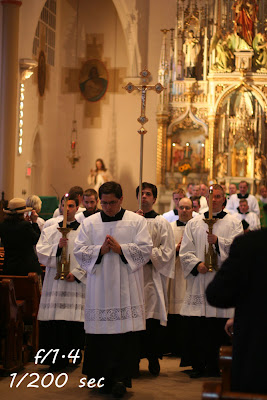As we all know, God said “Let there be light,” and there was. Unfortunately, this doesn’t often apply inside churches. The relative darkness inside can often be prohibitive when trying to take pictures in church. However, there are a few ways to make the best of a dark situation.
First, let me explain a few basic things about photography. The shutter of your camera opens to a certain width, for a certain amount of time, to let in the right amount of light. This balance is called exposure. Below are examples of underexposed, properly exposed, and overexposed photos. (click on this, and any, image to enlarge)

On an automatic setting, the camera will find a balance between shutter speed and opening width (also called “aperture”). Rather than try to explain all the implications of different balances, I’ll provide the following diagram, which will hopefully shed some light (no pun intended) on how things work.

If you want everything to be in sharp focus, you’ll need a higher f/stop, which means that the shutter speed needs to be longer (following along on the chart?). This has two drawbacks: first, it’s harder to hold the camera steady (a professor once told our class that anything longer than 1/60 sec. is impossible to keep steady. I find that I’m okay up to 1/15, but your results may vary.). Second, people in your photograph are more likely to move, thus becoming blurry (see below). So, if you're trying to take a picture of the beautifully set up altar before Mass, motion won't be a problem. During Mass, you're more likely to have problems.

The photos below are both properly exposed, but have different f/stops. See the difference? The wide aperture limits the range of what is in focus. A relatively flat surface, like an altar or a stained glass window, can handle this. A broader subject, like a shot of the whole interior of a church, will end up with a more selective focus.

The two photos below were both taken at an aperture of f/1.4 (very wide open). This was necessary in the confessional picture, in order to shorten the shutter speed as much as possible. Unfortunately, as you can see, it wasn’t enough and there's motion blur. In the picture on the right, the light coming through the window shortened the shutter speed dramatically.

One way to avoid motion blur is to rest the camera on a pew. It's like a built-in tripod, and while it won't steady the camera totally, it can help a lot.
What’s the lesson here? Get as much light as possible in the shot. This may require zooming out further than you want to, in order to catch more light. That’s okay - you can crop later (and that’s why you also want to have your camera on the highest pixel setting). Take the picture below, for example. Suppose that all I really wanted was the image of Lazarus. Zooming in eliminates too much light to get a clear shot. Getting as much light as possible and then cropping gives the result I want.

Another way to get sharp images, especially of people moving, is to switch your camera to sports mode, if it has one. On my camera, this is indicated by a little icon of a man running. On others, it’s called “Kids and Pets mode” or something. If you’re not sure whether your camera has this, or how to turn it on, consult your manual. This mode will automatically shorten the shutter speed as much as possible to minimize motion blur. During a recent Mass, I was unable to get the clarity I wanted in manual mode, despite my best efforts. I switched to action mode, and voila! Everything was clear again.

Up next: Stained glass windows (because some of us are visual learners)

2 comments:
I have a question - would it be possible to get a good photo of someone who is indoors, but who has the bright light of a door or window behind her? Specifically, I'm thinking of a bride walking down the aisle, with a sunlit doorway behind her.
The simple answer to your question is "maybe," but since that's not necessarily helpful, I'll explain more.
When deciding how to expose the photo, your camera will pick one part of the image to expose properly. So, if it fixes on the bright door/window, it will darken the entire image accordingly so that the door appears correctly. However, your bride, having been darkened the same amount, will be a mere silhouette (and if that's the look you're going for, you're all set). On the other hand, if you want the bride to be properly lit up, the bright area behind her will likely become VERY bright (and may give her quite a glowing effect).
If you focus the camera on the bride, rather than the doorway, your exposure should follow suit. If it still seems a little off, some cameras (even point and shoot models) have a feature that will allow you to tweak the exposure by hand. Check your manual for details.
And of course, it's always helpful to pull your camera out ahead of time and take some test pictures to get a sense of how the lighting will work.
Post a Comment